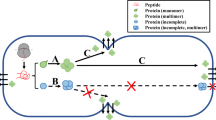Abstract
In this study, a naturally unsecretory intrinsically disordered domain of nucleoskeletal-like protein (Nsp) was attempted to be secreted with different types of secretion signals in Bacillus subtilis. The results showed that Nsp can be secreted efficiently by all selected Sec-type signal peptides. Nsp was successfully exported when fused to Tat-type signal peptides but less efficient than Sec-type. The fusion protein with the non-classical extracellular proteins can be detected in the cell and extracellular milieu. This study further demonstrated that the mature protein plays an important role in protein secretion. Moreover, these results indicated that Nsp could be a useful tool to understand the individual roles of mature proteins and signal peptide in protein secretion, to evaluate the effect of conformation of mature proteins on their export pathway when coupled with Tat-type signal peptide, and to seek the signal of non-classical secretory proteins.



Similar content being viewed by others
References
Anagnostopoulos C, Spizizen J (1961) Requirements for transformation in Bacillus subtilis. J Bacteriol 81:741–746
Baneyx F, Mujacic M (2004) Recombinant protein folding and misfolding in Escherichia coli. Nat Biotechnol 22:1399–1408
Brockmeier U, Caspers M, Freudl R, Jockwer A, Noll T, Eggert T (2006) Systematic screening of all signal peptides from Bacillus subtilis: a powerful strategy in optimizing heterologous protein secretion in gram-positive bacteria. J Mol Biol 362:393–402
Brockmeier U, Wendorff M, Eggert T (2006) Versatile expression and secretion vectors for Bacillus subtilis. Curr Microbiol 52:143–148
Chen MW, Nagarajan V (1993) Chloramphenicol acetyltransferase, a cytoplasmic protein is incompatible for export from Bacillus subtilis. J Bacteriol 175:5697–5700
Cohen SN, Chang ACY, Hsu L (1972) Nonchromosomal antibiotic resistance in bacteria: genetic transformation of Escherichia coli by R-factor DNA. Proc Natl Acad Sci USA 69:2110–2114
Cooper DN, Barondes SH (1990) Evidence for export of a muscle lectin from cytosol to extracellular matrix and for a novel secretory mechanism. J Cell Biol 110:1681–1691
Jacobs MF, Andersen JB, Borchert TV, Kontinen VP (1995) Identification of a Bacillus subtilis secretion mutant using a beta-galactosidase screening procedure. Microbiology 141:1771–1779
Jongbloed JDH, Grieger U, Antelmann H, Hecker M, Nijland R, Bron S, van Dijl JM (2004) Two minimal Tat translocases in Bacillus. Mol Microbiol 54:1319–1325
Kolkman MAB, van der Ploeg R, Bertels M, van Dijk M, van der Laan J, van Dijl JM, Ferrari E (2008) The Twin-arginine signal peptide of Bacillus subtilis YwbN can direct either Tat- or Sec-dependent secretion of different cargo proteins: secretion of active subtilisin via the B. subtilis Tat pathway. Appl Enviro Microbiol 74(24)):7507–7513
Lee C, Li P, Inouye H, Brickman ER, Beckwith J (1989) Genetic studies on the inability of beta-galactosidase to be translocated across the Escherichia coli cytoplasmic membrane. J Bacteriol 171:4609–4616
Li WF, Zhou XX, Lu P (2004) Bottlenecks in the expression and secretion of heterologous proteins in Bacillus subtilis. Res Microbiol 155:605–610
Meissner D, Vollstedt A, van Dijl JM, Freudl R (2007) Comparative analysis of twin-arginine (Tat)-dependent protein secretion of a heterologous model protein (GFP) in three different gram-positive bacteria. Appl Microbiol Biotechnol 76:633–642
Natale P, Brüser T, Driessen AJM (2008) Sec- and Tat-mediated protein secretion across the bacterial cytoplasmic membrane—distinct translocases and mechanisms. Biochim Biophys Acta 1778:1735–1756
Rubartelli A, Cozzolino F, Talio M, Sitia R (1990) A novel secretory pathway for interleukin-1β, a protein lacking a signal sequence. EMBO J 9:1503–1510
Simonen M, Palva I (1993) Protein secretion in bacillus species. Microbiol Rev 57:109–137
Tjalsma H, Antelmann H, Jongbloed JD, Braun PG, Darmon E, Dorenbos R, Dubois JY, Westers H, Zanen G, Quax WJ, Kuipers OP, Bron S, Hecker M, van Dijl JM (2004) Proteomics of protein secretion by Bacillus subtilis: separating the “secrets” of the secretome. Microbiol Mol Biol Rev 68:207–233
Vladimir N, Uversky A, Dunker K (2010) Understanding protein non-folding. Biochim Biophys Acta 1804:1231–1264
Xia Y, Zhao J, Chen H, Liu X, Wang Y, Tian F, Zhang HP, Zhang H, Chen W (2010) Extracellular secretion in Bacillus subtilis of a cytoplasmic thermostable β-galactosidase from Geobacillus stearothermophilus. J Dairy Sci 93:2838–2845
Yamada J, Phillips JL, Patel S, Goldfien G, Calestagne-Morelli A, Huang H, Reza R, Acheson J, Krishnan VV, Newsam S, Gopinathan A, Lau EY, Colvin ME, Uversky VN, Rexach MF (2010) A bimodal distribution of two distinct categories of intrinsically disordered structures with separate functions in FG nucleoporins. Mol Cell Proteomics 9:2205–2224
Yang CK, Ewis HE, Zhang X, Lu CD, Hu HJ, Pan Y, Abdelal AT, Tai PC (2011) Nonclassical protein secretion by Bacillus subtilis in the stationary phase is not due to cell lysis. J Bacteriol 193:5607–5615
Acknowledgments
We thank Hamid Majeed for critical review of this manuscript. This work was supported by the National Science Fund for Distinguished Young Scholars (31125021), the National High Technology Research and Development Program of China (2011AA100905), the National Natural Science Foundation of China (No. 31171636), the Key program of National Natural Science Foundation of China (No. 20836003), the National Basic Research Program of China 973 Program (2012CB720802), the 111 project B07029, and SKLF-TS-201101.
Author information
Authors and Affiliations
Corresponding authors
Electronic supplementary material
Below is the link to the electronic supplementary material.
Rights and permissions
About this article
Cite this article
Wang, G., Chen, H., Zhang, H. et al. The Secretion of an Intrinsically Disordered Protein with Different Secretion Signals in Bacillus subtilis . Curr Microbiol 66, 566–572 (2013). https://doi.org/10.1007/s00284-013-0315-8
Received:
Accepted:
Published:
Issue Date:
DOI: https://doi.org/10.1007/s00284-013-0315-8




